Evaluation and reviews of the ColorSpan DisplayMaker HiRes wide format printer.
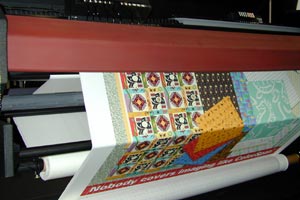 |
At last a wide format printer that produces photographic quality enlargements. You can inspect the detail up close when the print is by a ColorSpan printer. Try looking closely (and critically) at the results from an Encad printer. You see all the dots and pattern of the limited dpi.
Look instead at the results from a ColorSpan wide format printer. ColorSpan is a company which grew out of LaserMaster, well known for their advanced laser printers in a previous era. ColorSpan now makes a printer that can do floor graphics, backlit signs, murals, trade show displays, point of purchase (POP) signage, as well as posters, banners, and typical wide format products.
This kind of printer was especially good choice for a professional photo studio (photo lab), print shop, copy center, or advertising bureau in the heyday of water-based printers (1995-2003). ColorSpan is a complex technical printer; this is not something for a one-person or husband-and-wife team, unless you need the quality and can afford the correspondingly high cost of maintenance. However you can learn to handle the printer on your own. Our lab manager, Brent Cavanaugh, took the training directly from ColorSpan (it’s free to any owner of a ColorSpan printer). We tend to never need actual tech support except when a new student accidentally messes things up in a moment of over-enthusiasm.
If you need help deciding what wide format color printer to buy, send an e-mail to the review editor, Nicholas Hellmuth ([email protected]) Please be sure to mention what kind of images you reproduce, what your market is, your level of experience such as whether you are new to digital printing, and what printers did you consider before reading the reviews on this site. Indicate roughly your budget since it makes little sense to lust after a printer that is overly costly. We prefer to recommend cost-effective printers that produce photo-realistic quality with long-lasting colors using archival inks.
For museums a printer such as this would be an asset in fund raising. Museums could do exhibits more economically if the curators and in-house photo staff had access to a wide-format printer. With a local network everyone in the building can easily print from a single printer. Just send your files over the network.
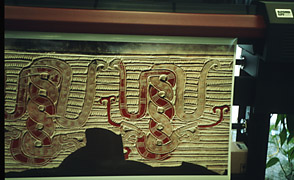 |
During the years when water-based printers were the desired ink chemistry, ColorSpan
made a wide selection of fine printers. The one pictured
here is the Ilford IJT from Ilford Imaging. This is the ColorSpan
DisplayMaker HiRes with 8-color technology. The 8-colors are
what give it the High Resolution.
Archival inks from Ilford are specially formulated to last
as long as possible. Archive inks have a well deserved reputation
for brightness. During the test what impressed me the most
was how true the colors are when printed on the ColorSpan.
Unfortunately the flash used to take this snapshot was not
wide enough to cover the field of view of the wide angle lens.
Since June 2001, you get the ColorSpan inks.
Elsewhere we report on the ColorSpan RIP. We are using the 1 GHz model. Very impressive RIP. Easy to set up, powerful yet easy to use, very well documented. Every step of installation of the printer was available in drawings as well as on a video (on CD). We rate the thoughtfulness of the user setup manual as 10 on a scale of 10.
Take the speed statistics with a grain of salt (which means reduce them considerably). Remember the rule, fast speed = low dpi, low dpi = less quality. Hence, fast speed = less quality.
The advantage of getting the Ilford IJT version of this printer from Ilford is that they prepare everything. You get trained at your own desk; everything is hooked up, and ready to go. Technicians assist when you need assistance (which should be almost never, since everything works just fine). Ilford can provide the proper monitor, every necessary item of computer equipment, software, hardware...a total solution. What an easy way to gain access to this remarkable wide format color printing technology.
Don't try to buy one of these printers over the internet and try to install it yourself. A ColorSpan is a printer where you need the printer, the RIP, the media, the inks, and all their ICC profiles together in one package. This is an integrated system, the only way to set up a printer of this nature.
Take the speed statistics with a grain of salt (which means reduce them considerably). Remember the rule, fast speed = low dpi, low dpi = less quality. Hence, fast speed = less quality.
Naturally what you want is slow speed = the highest quality. The ads show you the high quality, brag a bit about the high speed, and the reader loses track and presumes the high quality is of course also available at the high speed. No, its not like that.
If you are good with electronics, if you have already run a printing company (with traditional presses), or if your company is large enough to have a person who likes to work on equipment such as a ColorSpan printer, then you should consider this printer. We recommend, however, primarily a factory-new printer. If a demo or reconditioned, then we recommend under the agreement (written agreement) that it will be replaced or purchase price refunded in full if the printer does not function as advertised. You will need a maintenance agreement for as long as you intend to own the printer. Indications from actual users are that these printers require occasional replacement of major and costly electronic parts, which is covered by the service agreement (which I would guess costs somewhere about $5000 per year). Actually our Mach 12 was used when we got it, and it is into its second year: runs just fine.
What are your alternatives? Roland offers good quality but much slower. Roland is supposed to run around the clock, which is why it costs more than the Epson. Roland also offers archival inks which are more mature than any new inks. Downside is the Roland's propensity to banding, printhead disabilities, and slowness. This can pop up at any time and ruin your images.
Another alternative is the HP 3000, 3500, or 3800, after all, these models use the same heads as the ColorSpan XII. ColorSpan is wider, somewhat faster, and noticeably higher dpi. HP DesignJet printers, however, work seemingly forever with no maintenance and you can buy two for the price of a ColorSpan.
The newer Esprit model of ColorSpan changes this. Now you get the same quality (eight colors) yet for the price of an HP DesignJet. Of course HP itself has upped the ante by producing its own 1200 dpi six color printer, the HP 5000ps and now the 5500.
If you want to knock people's eyes out with quality, at an art exhibit, trade show, or whatever, then you need those extra dpi offered by ColorSpan. We will be doing an in-depth analysis of the ColorSpan loaded with 12 different colors, so check back in shortly for more information. If you have read a lot of the FLAAR reviews you can probably note that my favorite for entry-level through mid-level is the HP and my favorite for high-end is the ColorSpan. I like the Roland and Epson but if I won the lottery and could afford any printer I would opt for a ColorSpan in the inkjet category. If I won a second lottery, then I would also want a Cymbolic Sciences LightJet or Durst Lambda (about a quarter of a million dollars). In comparison the ColorSpan is a bargain.
ColorSpan makes a range of impressive printers, from the 8-ink HiRes model reported upon here to 12 color DisplayMaker Series XII wide format printer. ColorSpan also makes the Mach 12 which we also have at our university. Probably the only university with two ColorSpan printers in the same lab. We are loading the Mach 12 with a quad-black set combined with seven additional colors. So check back in once we start producing photo enlargements with this much color gamut.
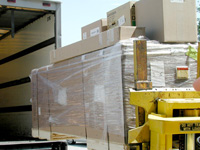 |
Another printer arrives at the FLAAR evaluation center at Bowling Green State University, Ohio. |
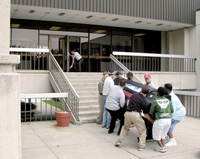 |
Took
less than an hour to mount the DisplayMaler XII from
the box, then up to the second floor in the College
of Technology. |
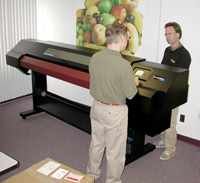 |
Bruce Butler, product marketing manager got the DisplayMaker XII up and running in about 2 hours. Professor Chuck Spontelli prepares to send the first files. |
Subsequently ColorSpan was bought by a new company, MacDermid. The new MacDermid ColorSpan has an entirely new policy of taking better care of the customer and attending to maintenance and service. I have kept an eye on ColorSpan, the company and its printers, for several years. The Esprit, costs half of previous models and gives the same legendary quality. FLAAR has the XII and the Mach 12. They print just fine year after year.
The X12 is another model of these water-based printers. Most of these models are available used; spare-parts and tech support is still available for elderly ColorSpan printers. I recently saw one company that had three of the models they made before I was even studying these technologies (the ColorSpan with piezo heads that used solid (wax) ink. These ColorSpan printers were still working (over 10 years old).
Today (2007) ColorSpan offers primarily UV-cured printers, in two series: 5440uv-series and 9840uv. For additional information on ColorSpan printers, contact Bruce Butler at e-mail [email protected] If there is no answer or if this e-mail address does not function just let us know.
Most recently updated July 31, 2007.
Previous updates: Jan. 3, 2003, July 06, 2001.
